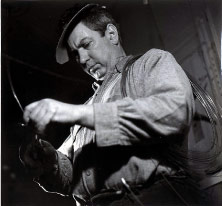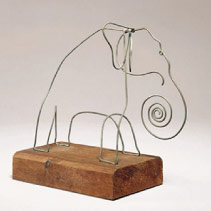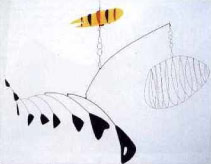Hey Kids, Meet Alexander Calder
from the Hey Kid's, Meet the Artist! Index
 |
Alexander Calder
(1898-1976) American Artist, Sculptor and Toy Maker
Preview and Print
Preview and print this free printable artist biography by clicking on the orange button.

|
Alexander Calder was born in 1898, in Lawnton, Pennsylvania. He was born into a family of artists. His father Alexander Stirling Calder was a prominent sculptor who created many public sculptures in the Philadelphia area. Calder's mother, Nanette Lederer Calder, was a professional portrait painter who studied art in Paris before moving to Philadelphia where she met her husband Alexander Stirling Calder.
In 1902, at the age of four, Alexander completed his first sculpture - a clay elephant. In 1909, when he was in the fourth grade, Alexander sculpted a dog and a duck from a sheet of brass. The duck, which could rock back and forth, is one of his earliest examples of his interest in kinetic (moving) sculpture.
Although Calder's parents supported Alexander's creativity, they discouraged their children from becoming artists, as the life of an artist is often uncertain and financially difficult. In 1915, following his parents advice, Calder decided to study mechanical engineering, and enrolled in the Stevens Institute of Technology in Hoboken, New Jersey. Four years later he received his degree.
Calder's interest in art never left him. Though he had tried to please his parents by becoming an engineer, he decided to pursue a career in art instead.
In 1923 Calder began attending the Art Students' League in New York. While attending this school he also worked as a freelance artist for the National Police Gazette. For one of his assignments he spent two weeks sketching scenes from the Ringling Brother's and Barnum & Bailey Circus. This project marked the beginning of his fascination with the circus.
In 1926 Calder moved to Paris where he began to build toys that moved. Eventually his collection of toys became a miniature circus which performed in the USA and Europe.
Calder's interest in kinetic art led him to create mobiles. Many of his later works are large delicately balanced mobiles produced for public buildings throughout the world.
Alexander Calder died on November 11, 1976 in New York. He is most remembered for inventing the mobile.
Alexander Calder Lesson Resources
Calder Cookies | Art Lesson
Lobster Trap | Coloring Page
Alexander Calder | Wire Sculpture Horse
Alexander Calder | Word Search Worksheet
"Meet the Artist" Job Application | Worksheet
Alexander Calder Art Gallery
 |
Elephant (1928) by Alexander Calder |
Wire and Wood
Elephant was created shortly after Calder moved to Paris.
|
 |
Lobster Trap and Fish Tail (1938) by Alexander Calder |
Sheet Metal, Wire and Paint Mobile
Lobster Trap and Fish Tail was created 5 years after Calder returned from Paris, having developed from a painter and illustrator, to one of the greatest sculptor of the twentieth century. Calder regarded his new form of artistic expression as "drawing in space".
|

Image: Calder in his New York City storefront studio in the winter of 1936 @ Calder Foundation
|